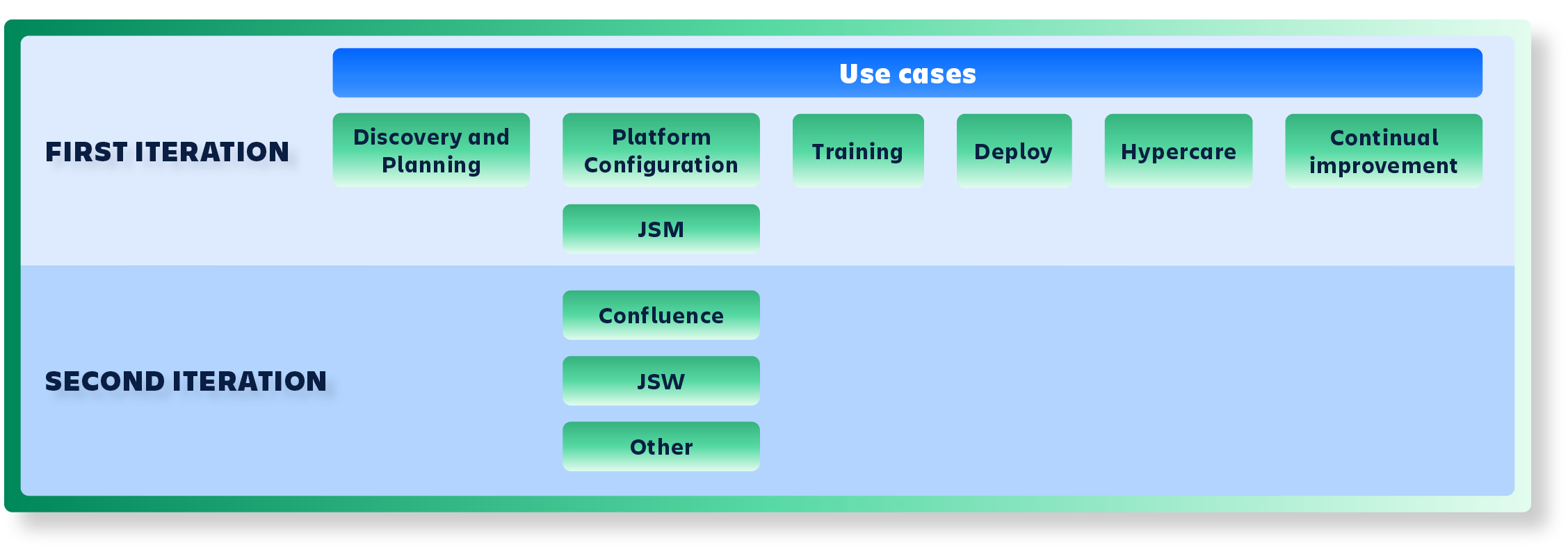Delivery overview: Discovery

Discovery
Communication and collaboration
- Define communication channels: Identify the best communication channels for different types of information and stakeholders. Ensure that everyone is aware of the channels being used and how to access them.
- Conduct regular meetings: Schedule regular meetings with the project team, stakeholders, and any other relevant parties. These meetings can be used to review progress, discuss any issues or concerns, and plan the next steps.
- Assign clear roles and responsibilities: Ensure that each team member and stakeholder knows their specific project roles and responsibilities. This can help avoid confusion and ensure tasks are completed on time.
- Encourage open communication: Encourage team members and stakeholders to ask questions, provide feedback, and share their ideas. This can help to identify potential issues early on and foster a collaborative environment.
- Use Jira platform collaboration features: Jira has many features that can be used to improve communication and collaboration. For example, use @mentions to draw attention to specific team members or stakeholders, use labels to categorize and track issues, and custom fields to capture additional information about tasks or issues.
Clearly defined goals and objectives
- Define SMART goals: Set clear and specific goals that are measurable, achievable, relevant, and time-bound. This will help to ensure that everyone involved in the ITSM implementation is working towards the same objectives.
- Conduct a needs analysis: Identify the specific pain points and challenges the ITSM solution intends to address. This will help ensure that the solution is tailored to meet the organization's specific needs.
- Conduct a gap analysis: Determine the current state of the organization’s ITSM capabilities and identify the gaps that must be addressed to achieve the desired future state.
- Define success criteria: Identify the metrics that will be used to measure the success of the ITSM implementation. This will help ensure that progress is being tracked and the project is on track to achieving its goals.
- Involve stakeholders: Ensure that all relevant stakeholders are involved in the goal-setting process. This includes senior management, IT staff, and end-users.
- Prioritize goals: Prioritize goals based on their level of importance and urgency. This will help to ensure that the most critical objectives are addressed first.
- Develop an action plan: Develop an action plan that outlines the specific steps that need to be taken to achieve the ITSM goals and objectives.
- Communicate goals and objectives: Communicate the goals and objectives to all stakeholders and ensure that everyone is aware of their role in achieving them. This will help to foster a collaborative and focused approach to the ITSM implementation.
Stakeholder involvement
- Identify key stakeholders: Identify the stakeholders who will be affected by the ITSM implementation and their roles in the process. This could include senior management, IT staff, end-users, and external vendors.
- Involve stakeholders in discovery and design: Involve stakeholders in the discovery and design phases of the project. This could include conducting surveys, focus groups, or interviews to gather feedback on what stakeholders need from the ITSM solution.
- Engage stakeholders in ownership: Engage stakeholders in the ownership of the ITSM solution. This could involve establishing a governance structure and involving stakeholders in decision-making processes.
- Include stakeholders in testing: Involve stakeholders in the testing phase of the project. This could include user acceptance testing to ensure the ITSM solution meets end-users’ needs.
Pro tip: By involving stakeholders throughout the ITSM implementation process, organizations can increase buy-in and ensure the solution meets the needs of all parties involved.
Previous step:
Next step:
Delivery overview: PlanningWas this content helpful?
Connect, share, or get additional help
Atlassian Community